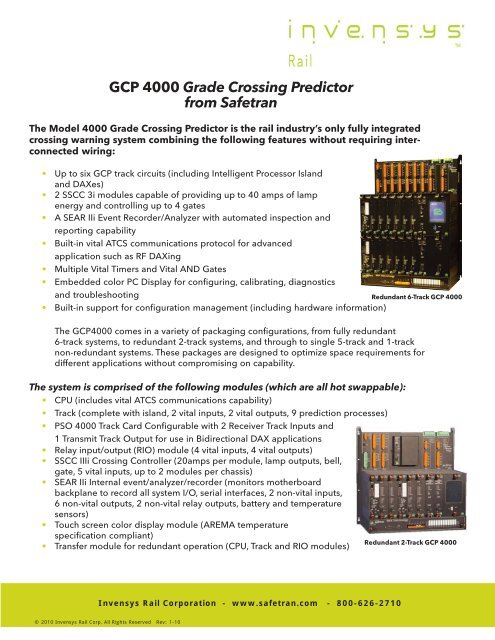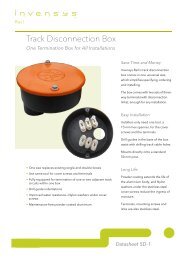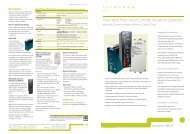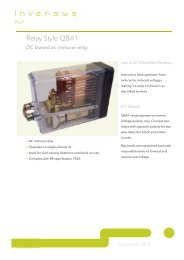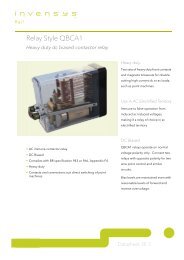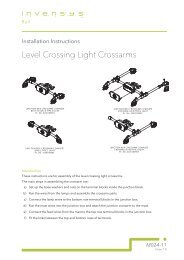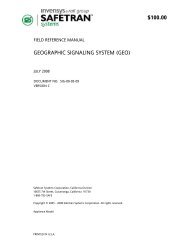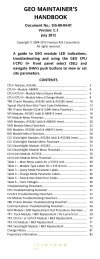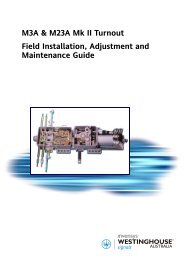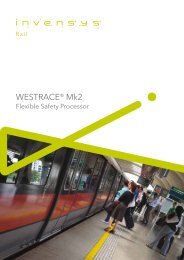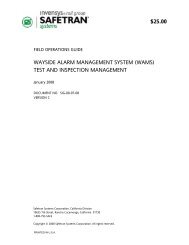Gcp 4000 grade crossing predictor from safetran - Invensys Rail
Gcp 4000 grade crossing predictor from safetran - Invensys Rail
Gcp 4000 grade crossing predictor from safetran - Invensys Rail
Create successful ePaper yourself
Turn your PDF publications into a flip-book with our unique Google optimized e-Paper software.
<strong>Invensys</strong> <strong>Rail</strong> Corporation - www.<strong>safetran</strong>.com - 800-626-2710<br />
© 2010 <strong>Invensys</strong> <strong>Rail</strong> Corp. All Rights Reserved Rev: 1-10<br />
GCP <strong>4000</strong> Grade Crossing Predictor<br />
<strong>from</strong> Safetran<br />
The Model <strong>4000</strong> Grade Crossing Predictor is the rail industry’s only fully integrated<br />
<strong>crossing</strong> warning system combining the following features without requiring interconnected<br />
wiring:<br />
• Up to six GCP track circuits (including Intelligent Processor Island<br />
and DAXes)<br />
• 2 SSCC 3i modules capable of providing up to 40 amps of lamp<br />
energy and controlling up to 4 gates<br />
• A SEAR IIi Event Recorder/Analyzer with automated inspection and<br />
reporting capability<br />
• Built-in vital ATCS communications protocol for advanced<br />
application such as RF DAXing<br />
• Multiple Vital Timers and Vital AND Gates<br />
• Embedded color PC Display for configuring, calibrating, diagnostics<br />
and troubleshooting<br />
• Built-in support for configuration management (including hardware information)<br />
The GCP<strong>4000</strong> comes in a variety of packaging configurations, <strong>from</strong> fully redundant<br />
6-track systems, to redundant 2-track systems, and through to single 5-track and 1-track<br />
non-redundant systems. These packages are designed to optimize space requirements for<br />
different applications without compromising on capability.<br />
The system is comprised of the following modules (which are all hot swappable):<br />
• CPU (includes vital ATCS communications capability)<br />
• Track (complete with island, 2 vital inputs, 2 vital outputs, 9 prediction processes)<br />
• PSO <strong>4000</strong> Track Card Configurable with 2 Receiver Track Inputs and<br />
1 Transmit Track Output for use in Bidirectional DAX applications<br />
• Relay input/output (RIO) module (4 vital inputs, 4 vital outputs)<br />
• SSCC IIIi Crossing Controller (20amps per module, lamp outputs, bell,<br />
gate, 5 vital inputs, up to 2 modules per chassis)<br />
• SEAR IIi Internal event/analyzer/recorder (monitors motherboard<br />
backplane to record all system I/O, serial interfaces, 2 non-vital inputs,<br />
6 non-vital outputs, 2 non-vital relay outputs, battery and temperature<br />
sensors)<br />
• Touch screen color display module (AREMA temperature<br />
specification compliant)<br />
• Transfer module for redundant operation (CPU, Track and RIO modules)<br />
Redundant 6-Track GCP <strong>4000</strong><br />
Redundant 2-Track GCP <strong>4000</strong>
The GCP<strong>4000</strong> interfaces to a variety of external sensors in order to<br />
perform automated <strong>crossing</strong> inspection. These sensors collect information<br />
regarding gate tip position, gate position, bell status (sensor<br />
is built in to Safetran's Electronic Bell), lamp status, battery status,<br />
and ground fault status. This information is analyzed and communicated<br />
to Safetran's Wayside Alarm Management System (WAMS)<br />
web-based office system. WAMS produces the required FRA reports,<br />
schedules and stores the inspection results, and processes any<br />
<strong>crossing</strong> alarms.<br />
The SEAR IIi incorporates enough inputs to monitor all of the I/O for<br />
a fully loaded 6 track redundant GCP<strong>4000</strong> without the need for additional<br />
wiring (this is accomplished via the motherboard). The SEAR IIi internal<br />
recorder module implements, via the GCP<strong>4000</strong> display module, the same<br />
user interface as the SEAR II external unit, so anyone familiar with the SEAR<br />
II will be able to use the SEAR IIi.<br />
The vital ATCS communications protocol capability built-in to the GCP<strong>4000</strong><br />
CPU provides a similar capability to that of the HD/Link allowing vital data<br />
to be sent <strong>from</strong> one GCP<strong>4000</strong> to another, without having to use the<br />
HD/Link modules. GCP<strong>4000</strong>’s can be connected directly to each other<br />
via the Echelon LAN, or may communicate via Safetran’s Spread Spectrum<br />
Radio or other communications medium that may be available. An external<br />
Wayside Access Gateway product <strong>from</strong> Safetran can be used to convert the<br />
GCP<strong>4000</strong> Echelon LAN to a variety of other media, such as Ethernet,<br />
RS232, RS485 etc. This feature allows for “Radio DAXing” operations (up<br />
to 9 DAXes x 6 Tracks can be sent), as well as transmission of other vital<br />
data pertinent to <strong>crossing</strong> operation. The vital communications links are<br />
field programmable - an office-based compiler is no longer needed.<br />
The GCP<strong>4000</strong> system has a unique feature that allows a single person<br />
to safely calibrate, test and troubleshoot a <strong>crossing</strong>. Using a VHF<br />
Communicator module attached to the GCP<strong>4000</strong>, a maintainer can use<br />
a standard handheld VHF radio to calibrate the GCP track circuit (GCP,<br />
approach, linearization and island) without having to have a second<br />
maintainer by the GCP equipment. A single maintainer may also calibrate<br />
lamp voltages, as well as obtain readings of EZ, EX and island condition<br />
via radio. The process is protected by a priming function, and use of a<br />
one-time randomly generated password. The maintainer will hear voice<br />
menu prompts, and respond back with DTMF key sequences. The VHF<br />
Communicator can also be used to hop alarm and test data between<br />
<strong>crossing</strong>s, as well as to “key down” the <strong>crossing</strong> via a VHF handset<br />
(e.g. <strong>from</strong> a hi-rail vehicle or maintenance truck).
The GCP<strong>4000</strong> eliminates the need for external vital AND gates and<br />
timers by providing flexible built-in AND gates and timers (pick-up<br />
delays, loss-of-shunt, gate delay timers). Multiple functions are also<br />
provided to interface to the signaling and traffic systems (such as<br />
AND enables, MS restart, wraps, <strong>predictor</strong> overrides etc).<br />
Advanced and simultaneous traffic signal preemption are provided,<br />
with capabilities for correspondence checking the preemption relay,<br />
as well as bringing in an optional traffic system health indication. Gate<br />
down logic and second train logic are also integrated into the system.<br />
The GCP<strong>4000</strong> may also be used in conjunction with Safetran’s SSCC<br />
IIIA, SSCC III Plus and SSCC IV <strong>crossing</strong> controllers for additional lamp<br />
and/or gate control (e.g. 4 quad gate <strong>crossing</strong>s, pedestrian gates, etc).<br />
Separate lamp and <strong>crossing</strong> control output functions are provided by<br />
the GCP<strong>4000</strong>, as well as mechanisms for bringing health and maintenance<br />
call information <strong>from</strong> the external controllers into the<br />
GCP<strong>4000</strong>. Flash synchronization is also provided.<br />
The system incorporates a powerful Display module that provides<br />
access to all of the programming features and provides advanced<br />
troubleshooting and diagnostics. Errors are indicated by a red<br />
screen. Next, the diagnostics tool provides a list of the errors and,<br />
then, further detail, complete with cause and remedy. The complete<br />
error list can be viewed without having to refer to a manual.<br />
The diagnostic tool interactively shows when errors have been<br />
corrected. The display can also show the status for up to 6 tracks<br />
simultaneously (including EZ, EX. train speed, island status).<br />
The system incorporates options to take the approach or the approach and island of each track out of<br />
service. An optional vital timer is provided to force the track back into service. An optional vital input<br />
may be selected to require use of an external strap to enable the out of service capability. Multiple test<br />
modes are provided, including steady and flashing lamps, timed lamp tests, and <strong>crossing</strong> activation.<br />
Tests can be performed <strong>from</strong> the display or <strong>from</strong> a VHF handset if the VHF Communicator is used.
The GCP<strong>4000</strong> uses a concept called template programming to<br />
simplify programming. The designer selects a <strong>crossing</strong> template<br />
that most closely matches the application, and then adjusts the<br />
programming as necessary. Only the exceptions to the template<br />
defaults need to be programmed, rather than every parameter.<br />
For a large system, this reduces potentially over 600 parameters<br />
to 20 to 40 parameters. The programming can also be confirmed<br />
via a CRC.<br />
The software that runs on the display module is also available to<br />
run on a Laptop or a PC under the Windows operating system.<br />
This software can be connected to the GCP<strong>4000</strong>, allowing realtime<br />
access to all of the programming and diagnostic features.<br />
The software can also be run in a stand- alone mode, called the<br />
Office Configuration Editor, which allows designers to select all<br />
of the programming options and then produce the exceptions<br />
report (the minimum set of programming steps needed to<br />
program the unit). This report is incorporated into the site plans,<br />
Most recently Safetran released three new features to further enhance the GCP <strong>4000</strong>. These<br />
include exclusive Bidirectional DAX capability, Track Check Number implementation and an<br />
Express Menu for configuring most applications. Bidirectional DAXing has the potential to<br />
provide the biggest initial cost saving initiative since introduction of the GCP <strong>4000</strong>, itself, in<br />
2003 because the need for additional insulated joints and other signaling material is greatly<br />
reduced compared to previous DAXing installations. Likewise, implementation of a Track<br />
Check Number has the potential to significantly reduce maintenance cost by providing the<br />
final CRC necessary for full verification of all vital parameter, configuration and calibration<br />
values over time allowing maintenance personnel to quickly and easily verify equipment<br />
status <strong>from</strong> one inspection to the next. The GCP <strong>4000</strong>’s Express Menu was developed to<br />
speed and simplify the configuration of most GCP <strong>4000</strong>’s applications, thus, allowing the unit<br />
to go into service in the field more quickly.
Summary of GCP<strong>4000</strong> Major Features<br />
• The rail industry’s only fully integrated, field-proven <strong>crossing</strong> warning system:<br />
o Field-proven operation since January 2003, over 5000 systems in revenue service!<br />
o Up to 6 GCP track circuits, with each track module having:<br />
• 1 GCP prime <strong>predictor</strong> (may also be configured as a motion sensor)<br />
• 7 discrete DAXes<br />
• Prime and preempt <strong>predictor</strong>s may also be used as DAXes for a total of 9 DAXes per<br />
track, a maximum of 54 DAXes per GCP<strong>4000</strong><br />
• Bidirectional DAXing Capability<br />
• 1 preempt<br />
• 1 Intelligent Processor Island<br />
• Two vital inputs and two vital outputs that are all user configurable<br />
o Up to 40amps of Crossing Controller (lamps, bell, gate), with 5 user configurable vital<br />
inputs, includes inverted gate output for exit gate control, and support for external<br />
Safetran <strong>crossing</strong> controller modules for additional lamp and/or gate control<br />
o Recorder/Analyzer with automated inspection capability:<br />
• External sensors monitor the gate mechanism; bell and lamp circuits; gate tip position;<br />
battery status; temperature levels and multiple ground fault testing modules<br />
• Powerful CDL application language provides advanced alarm capabilities<br />
• RS232/RS422 Serial interface to radio modems and cRTU<br />
• Hyperterminal interface<br />
o Built-in, field-programmable, vital ATCS communications protocol capability (radio<br />
DAXing function for up to 54 DAXes - no HD/Link required)<br />
o Up to 3 relay input/output (RIO) modules for an additional 4 vital inputs and 4 vital out<br />
puts per RIO (RIOs can be used in place of Track modules 2, 5 or 6)<br />
o Multiple, built-in, user configurable vital AND gates and vital timers<br />
• Significantly reduced wiring due to system integration and the internal SEAR IIi event<br />
analyzer/recorder - a single track system reduces house wiring costs by 30%.<br />
• Reduced size (compared to discrete components) has the potential for a smaller<br />
equipment house, or for more equipment to be housed in same sized equipment house<br />
• Full integration with Safetran’s web-based Wayside Alarm Management System (WAMS)<br />
office system including single-person remote test, setup, diagnostics and calibration using<br />
the VHF Communicator module, including DTMF “key-down” and alarm/recorder data<br />
hopping capabilities<br />
• Flexible interface to the signaling and traffic systems, including preemption logic, enable,<br />
wrap and override functions, field selectable LOS timers and pick-up delays
• Track out-of-service capability, with optional vital timer and optional vital external strap<br />
• Multiple test modes, including steady and flashing lamps, timed tests, and <strong>crossing</strong> tests<br />
• Regular line-wire DAXing can typically be accomplished without the need for adding extra<br />
I/O modules as each Track module has two vital outputs built-in<br />
• Color, touch-screen display module with advanced maintenance suite:<br />
o Simultaneous display of the status of up to 6 tracks (including EZ, EX, train speed,<br />
island status, activation status)<br />
o Directed troubleshooting, with interactive diagnostic log and with cause and remedy<br />
displays for each error (no need to refer to manual)<br />
o Maintainers log with trend history recording<br />
o Diagnostic history log of previous errors and train move history log<br />
o Utilizes same display interface as the external SEAR II<br />
• Office Configuration Editor allowing minimum programming steps to be specified by design<br />
• Simple field programmability with template programming (parameters are programmed by<br />
exception and can be confirmed with a CRC) -yet the system still provides very powerful<br />
programming capabilities, with a large number of options and control mechanisms<br />
• Multiple packaging configurations, utilizing common modules<br />
• Hot swappable modules (modules can be removed under power without damage)<br />
• Transfer module can be removed and a strap can be used to force either main or standby<br />
operation without the transfer module present<br />
• Supports Federal requirements for configuration management with the extensive configuration<br />
management information built-in to each module, electronically. Each module can be queried<br />
for software and hardware information and the system can be queried for programming<br />
information — an "electronic history card."<br />
• Reduced module count <strong>from</strong> a GCP3000 (recorder, display, SSCC IIli not duplicated in a<br />
redundant unit, plus integration of Track, Island and I/O)<br />
<strong>Invensys</strong> <strong>Rail</strong> Corporation<br />
2400 Nelson Miller Pkwy.<br />
Louisville, KY 40223<br />
www.<strong>safetran</strong>.com<br />
800-626-2710


